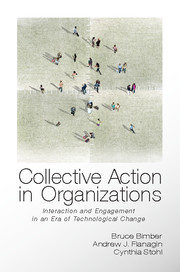Book contents
- Frontmatter
- Contents
- List of Figures and Tables
- Preface
- 1 Involvement in Organizational Collective Action in an Era of Technological Change
- 2 The Contemporary Media Environment and the Evolution of Boundaries in Organization-based Collective Action
- 3 The Collective Action Space
- 4 The American Legion, AARP, and MoveOn in Collective Action Space
- 5 Exploring Collective Action Space
- 6 Participatory Styles, the Individual, and the Contemporary Organization
- Appendix a Interaction and Engagement
- Appendix b Predicting Contribution, Identification, and Trust by Organization
- Appendix c Descriptive Statistics for the Participatory Styles
- References
- Index
3 - The Collective Action Space
Published online by Cambridge University Press: 05 June 2012
- Frontmatter
- Contents
- List of Figures and Tables
- Preface
- 1 Involvement in Organizational Collective Action in an Era of Technological Change
- 2 The Contemporary Media Environment and the Evolution of Boundaries in Organization-based Collective Action
- 3 The Collective Action Space
- 4 The American Legion, AARP, and MoveOn in Collective Action Space
- 5 Exploring Collective Action Space
- 6 Participatory Styles, the Individual, and the Contemporary Organization
- Appendix a Interaction and Engagement
- Appendix b Predicting Contribution, Identification, and Trust by Organization
- Appendix c Descriptive Statistics for the Participatory Styles
- References
- Index
Summary
Conceptualizing technology as creating a context for collective action where boundaries are easily crossed provides a way around the problem of taking too fine grained a view of technological tools and their use in a period in which technology is ubiquitous and rapidly changing. If the observations in Chapter 2 are right, then we have moved a step forward in thinking about collective action in organizational contexts. Completing that task, however, will require a clear view of the theory of collective action, against which the significance of diminished boundaries can be examined; this is the first goal of Chapter 3. We begin with a review of the key elements of collective action theory, consider further what diminished boundaries imply for this body of theory, and then focus on two particular boundaries: among members, and between members and organizational processes and decision making. This leads to the chapter's second goal, presenting our main theoretical framework, collective action space, which provides a way to conceptualize and measure people's experience of two important kinds of boundaries within collective action organizations.
Traditional Collective Action Theory and Its Modifications
Theories of collective action have a special place and rich heritage in the social sciences. Collective action is one of relatively few broadly discipline-spanning ideas, with important contributions from economics and political science (e.g., Chamberlin, 1974; Downs, 1957; Olson, 1965; Ostrom, 1990; Samuelson, 1954), sociology (e.g., Coleman, 1990; Marwell and Oliver, 1993; Oliver, 1993), communication (e.g., Connolly and Thorn, 1990; Fulk et al., 1996; Markus, 1990; Monge et al., 1998), and ecology (e.g., Hardin, 1982) among other disciplines. Collective action theory has been subject to a great deal of critique, modification, and elaboration. Much of this body of reaction to the basic theory of collective action was powerfully symbolized by the 2009 Nobel Prize in economics, which went to Ostrom for work showing how common pool resource problems, a form of collective action challenge, can in practice be solved through adequate institutional arrangements – that is, forms of organization. Because processes of collective action lie at the heart of so many social phenomena, they are an important part of the fabric of societies. People's involvement in community affairs, voluntary and charitable activities, larger social and political associations and identifications, levels of social trust, and participation in democracy are all connected to matters of collective action.
- Type
- Chapter
- Information
- Collective Action in OrganizationsInteraction and Engagement in an Era of Technological Change, pp. 74 - 105Publisher: Cambridge University PressPrint publication year: 2012



